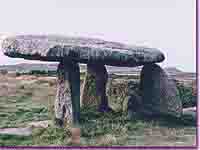|
|
Burial sites in West Penwith include burial mounds, or barrows;
and 'quoits', which are massive stone-sided chambers, with capstones
weighing up to 20 tonnes. The quoits were probably the burial places
of tribal leaders, and were most likely used as the focal points
of religious ceremonies. The quoits in Cornwall are estimated to
be between 5,000 and 6,000 years old.
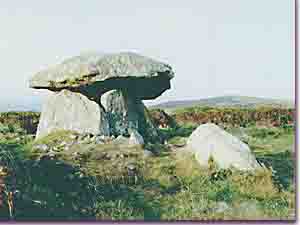 |
Chûn
Quoit
SW402339
Chún is a hollow chambered quoit surrounded by the
remains of a stone kerb. It stands just five minutes walk
from the ruins of Chûn Castle; a fortified settlement
dating from 300-200BC.
|
|
Lanyon
Quoit
SW430337
This is one of two quoits at Lanyon, this more accessible
one being maintained by the National Trust.
Although damaged by a storm in the early 19th C, it has an
eerie, imposing atmosphere against the backdrop of the surrounding
moor.
|
|
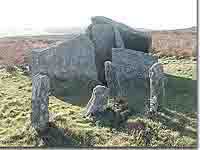 |
Zennor
Quoit
SW469380
Zennor is a 'portal' dolmen, having a small porch at its
entrance, flanked by two upright slabs.
About a mile and a half to the South West of it is Mulfra
Quoit and the Bronze Age village of Bodrifty. To the South
is the Iron Age village of Chysauster.
|
|
Ballowal
Barrow (Carn Gloose)
SW355312
Ballowal is an enormous entrance grave consisting of a stone
framework with a system of internal corridors leading to small
burial cists.
Built mainly in the Bronze Age it was once covered with earth
and stone, forming an elliptical mound. It was believed to
have started as a Stone Age burial site.
|
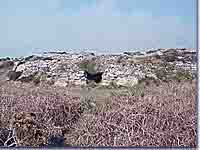
|
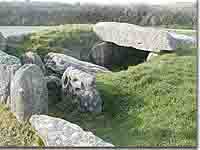 |
Tregiffian
Chamber Tomb
SW430244
Tregiffian is a chamber tomb, easily overlooked, near the
Merry Maidens, and
partly in-filled by the road. It is now overseen by English
Heritage.
Dating back to around 2,500BC, it is older than the circle,
but has also been used for a later burial around 1,900BC.
Note the 'cup' mark pattern in the nearby stone (which is
a copy - the original being in a museum at Truro).
|
TOP
|







